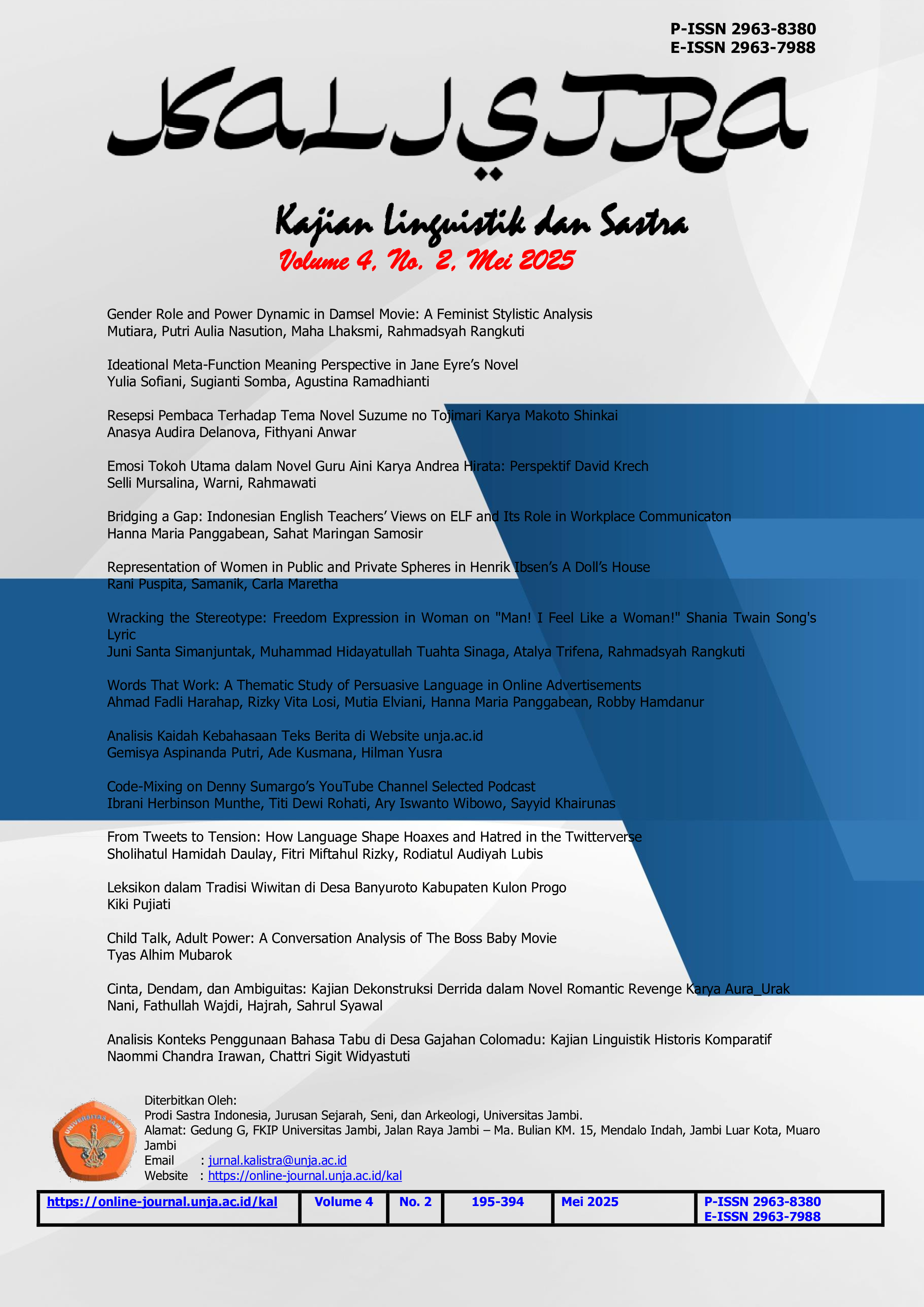Words That Work: A Thematic Study of Persuasive Language in Online Advertisements
DOI:
https://doi.org/10.22437/kalistra.v4i2.43431Keywords:
work, words, thematic, persuasive, online, advertisementAbstract
In the rapidly evolving digital era, online advertising has emerged as a central strategy in marketing communication. While language plays a crucial role in crafting persuasive advertisements, few studies have provided a thematic synthesis of the linguistic strategies used in online ads. This study aims to identify and synthesize persuasive linguistic strategies as discussed in recent academic literature. The research employs thematic analysis based on Braun and Clarke’s six-phase framework. Data were collected from ten peer-reviewed journal articles published between 2020 and 2025, each focusing on persuasive language in digital advertising. The analysis revealed four dominant themes: Emotional Resonance, Building Credibility, Interactive Appeal, and Aesthetic Persuasion. These findings demonstrate that language in online advertising is not only used to convey product information but also to establish emotional connections, build trust, stimulate audience engagement, and enhance the aesthetic appeal of the message. The study offers practical implications for advertisers, encouraging a focus on emotional and interactive elements in message construction. It also calls for further research into the effectiveness of these strategies across different digital platforms and cultural contexts.
Downloads
References
Abed, A. N., & Dakhil, T. A. (2021). A linguistic analysis of commercial adverts in English, Arabic and Russian. Multicultural Education, 7(10), 654–665. https://doi.org/10.5281/zenodo.5595364
Al-Bahrani, R. H., & Ali, S. K. (2021). A cognitive linguistic study of the persuasive/attention strategies used in selected American English e-advertisements. Arab World English Journal (AWEJ), Special Issue on CALL(7). https://dx.doi.org/10.24093/awej/call7.20
Al-Shboul, O. K., Al-Khawaldeh, N. N., Alkhawaldeh, A. A., Hamdan, H. J., & Al-Oliemat, A. S. (2024). Cognitive aspects of persuasion in marketing discourse: A cognitive linguistic study. Eurasian Journal of Applied Linguistics, 10(1), 81–91. https://doi.org/10.32601/ejal.10108
Al-Subhi, A. S. (2022). Metadiscourse in online advertisement: Exploring linguistic and visual metadiscourse in social media advertisements. Journal of Pragmatics, 187, 24–40. https://doi.org/10.1016/j.pragma.2021.10.027
Anigbogu, N. C., & Okere, M. C. (2021). Persuasive language in advertisement: Linguistic analysis of Stanbic IBTC and Access Banks’ online advertisements. IOSR Journal of Humanities and Social Science, 26(6), 41–46. https://doi.org/10.9790/0837-2606034146
Cialdini, R. B. (2007). Influence: The psychology of persuasion (Revised ed.). Harper Business.
Clarke, V., & Braun, V. (2013). Successful qualitative research: A practical guide for beginners. Sage.
Cook, G. (2001). The discourse of advertisement (2nd ed.). Routledge.
Filipowski, O. (2014). The impact of language on building the internal market: The consumer transactions perspective. Wroclaw Review of Law, Administration & Economics, 4(2), 60–71. https://doi.org/10.1515/wrlae-2015-0002
Flusberg, S. J., Holmes, K. J., Thibodeau, P. H., Nabi, R. L., & Matlock, T. (2024). The psychology of framing: How everyday language shapes the way we think, feel, and act. Psychological Science in the Public Interest, 25(3), 105–161. https://doi.org/10.1177/15291006241246966
Fuertes-Olivera, P. A., Velasco-Sacristán, M., Arribas-Baño, A., & Samaniego-Fernández, E. (2001). Persuasion and advertisement English: Metadiscourse in slogans and headlines. Journal of Pragmatics, 33(8), 1291–1307. https://doi.org/10.1016/S0378-2166(01)80026-6
Hidarto, A. (2021). The persuasive language of online advertisements featuring social media influencers on Instagram: A multimodal analysis. Indonesian JELT: Indonesian Journal of English Language Teaching, 16(1), 15–36. https://doi.org/10.25170/ijelt.v16i1.2550
Khedri, M., Hasan, E., & Kritsis, K. (2022). Rhetorical structure and persuasive features of advertisement: An intercultural analysis of English and Arabic online advertisements. Russian Journal of Linguistics, 26(3), 596–624. https://doi.org/10.22363/2687‐0088‐24591
Kotler, P., & Keller, K. L. (2016). Marketing management (15th ed.). Pearson.
Losi, R. V., & Rosida, S. (2022). Persuasive language used on advertisements of Instagram posts. Titian: Jurnal Ilmu Humaniora, 6(1), 54–63. https://online-journal.unja.ac.id/index.php/titian
Maharani, P., Paendong, S. M., & Amiruddin, N. (2024). Persuasive linguistic strategies in Indonesian e-commerce campaigns for the 2021 pandemic marketing framework. Lingua Cultura, 18(1), 117–131. https://doi.org/10.21512/lc.v18i1.11957
Melnichuk, M. V., Belogash, M. A., & Pisonova, M. (2020). Linguistic triggers as tools of managing consumer behavior. XLinguae, 13(4), 237–248. https://doi.org/10.18355/xl.2020.13.04.17
Pezzuti, T., Leonhardt, J. M., & Warren, C. (2021). Certainty in language increases consumer engagement on social media. Journal of Interactive Marketing, 53, 68–86. https://doi.org/10.1016/j.intmar.2020.06.005
Rahma Sari. (2024). Penggunaan bahasa persuasi dan elemen bahasa pada iklan makanan di YouTube. Jurnal Bima: Pusat Publikasi Ilmu Pendidikan Bahasa dan Sastra, 2(4), 265–273. https://doi.org/10.61132/bima.v2i4.1381
Shanahan, J. G., & Kurra, G. (2011). Digital advertisement: An information scientist’s perspective. In M. Rowe, M. Stankovic, & A. Dadzie (Eds.), Proceedings of the 1st International Workshop on Information Heterogeneity and Fusion in Recommender Systems (HetRec 2010) (pp. 103–110). Springer. https://doi.org/10.1007/978-3-642-20946-8_9
Wang, J. (2010). A critical discourse analysis of Barack Obama’s speeches. Journal of Language Teaching and Research, 1(3), 254–261. https://doi.org/10.4304/jltr.1.3.254-261
Downloads
Published
How to Cite
Issue
Section
License
Copyright (c) 2025 Ahmad Fadli Harahap, Rizky Vita Losi, Mutia Elviani, Hanna Maria Panggabean, Roobby Hamdanur

This work is licensed under a Creative Commons Attribution-ShareAlike 4.0 International License.
Kalistra: Kajian Linguistik dan Sastra is licensed under Creative Commons Attribution-ShareAlike 4.0 International License.
Authors who publish their manuscripts in Kajian Linguistik dan Sastra agree to the following terms:
1. The copyright in each article belongs to the author.
2. The author acknowledges that Kajian Linguistik dan Sastra reserves the right to be the first to publish under a Creative Commons Attribution-ShareAlike 4.0 International License (Attribution 4.0 International CC BY-SA 4.0).
3. Authors may submit articles separately, arranging for non-exclusive distribution of manuscripts that have been published in this journal to other versions (e.g., delivery to the author's institutional repository, publication into a book, etc.), acknowledging that the manuscript has been first published in Kajian Linguistik dan Sastra.
















